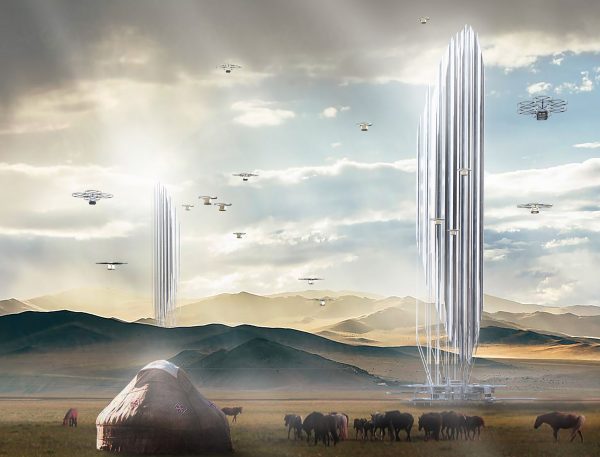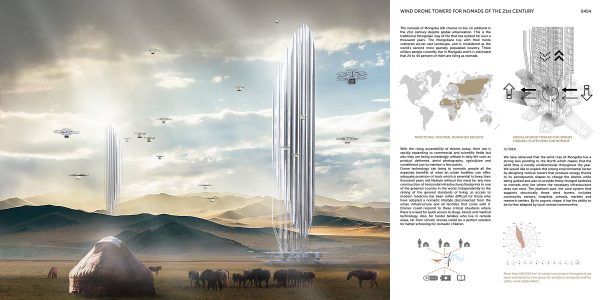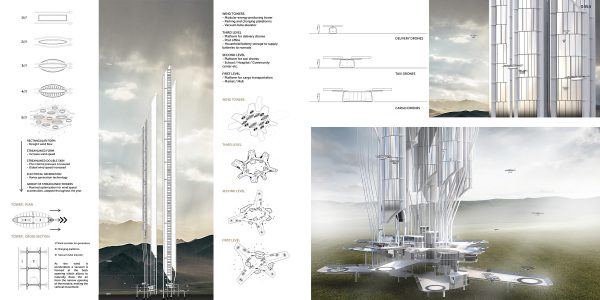Editors’ Choice
2019 Skyscraper Competition
Kiwon Hong, Namjung Kim
France, South Korea
NOMADS
The nomads of Mongolia still choose to live on wildland in the 21st century despite global urbanization. This is the traditional Mongolian way of life that has existed for over a thousand years. The Mongolians live with their herds scattered across a vast landscape and is considered as the world’s second most sparsely populated country. Three million people currently live in Mongolia and it is estimated that 24 to 40 percent of them are living as nomads.
TECHNOLOGY
With the rising accessibility of drones today, their use is rapidly expanding to commercial and scientific fields but also they are being increasingly utilized in daily life such as product deliveries, aerial photography, agriculture and surveillance just to mention a few points. Drone technology can bring to nomadic people all the expected benefits of what urban facilities can offer, adequate provision of tools which is essential to keep their thousand years old lifestyle without the need for any new construction of space-consuming horizontal infrastructures/footprints in one of the greenest country in the world. Independently to the raising of the general standards of living, access to modern medicine has been rather difficult for those who have adopted a nomadic lifestyle disconnected from the urban infrastructure and all facilities that come with it. Drones could respond to these critical situations where there is a need for quick access to drugs, blood, and medical technology. Also, for herder families who live in remote areas, far from school, drones could be a perfect solution for better schooling for nomadic children.
CONCEPT
According to the Wind Energy Resource Atlas of Mongolia, more than 160 000 km² of windy land areas in Mongolia have been estimated to have good-to-excellent wind potential for utility-scale applications. We have observed that the wind rose of Mongolia has a strong Axis pointing to the North which means that the wind flow is mostly unidirectional throughout the year. We would like to exploit this environmental factor by designing vertical-small footprint towers that produce energy thanks to its aerodynamic shapes to charge the drones while being parked vertically and also to provide freely charged batteries to nomads who live where the necessary infrastructure does not exist beside all other vital supplies needed. The platform part, the core system that supports structurally these wind towers, includes community centers, hospitals, schools, markets, and research centers. By its organic shape, it has the ability to be further adapted by local nomad communities. By designing this typology that will stimulate the local green economy, we shape the future of drone towers across all nomadism regions globally.
DESCRIPTION
Our proposal comprises a group of streamlined towers supported by a core of 3 leveled platforms raised from the ground for a lower footprint impact. We have 3 modules of towers for 3 types of drones. A tower module is comprised of vertically arrayed platforms that charge the drones with the energy generated by the bladeless wind turbines in the ‘wind corridor’. As the wind is accelerated thanks to the streamlined shape of the envelope, a vacuum is formed at the back opening which allows to naturally draw the air from the narrow opening of the tower, connected to the drones elevator making it easier its vertical movement. Concerning the lower part, the first level platform is for Cargo drones. There is a Market / Mall on this level. The second level is for taxi drones and is connected to school, hospital and community center buildings. The third level is a platform for delivery drones. Being the nearest level from the towers, there is a big storage room for household battery storage delivered to nomads.

















